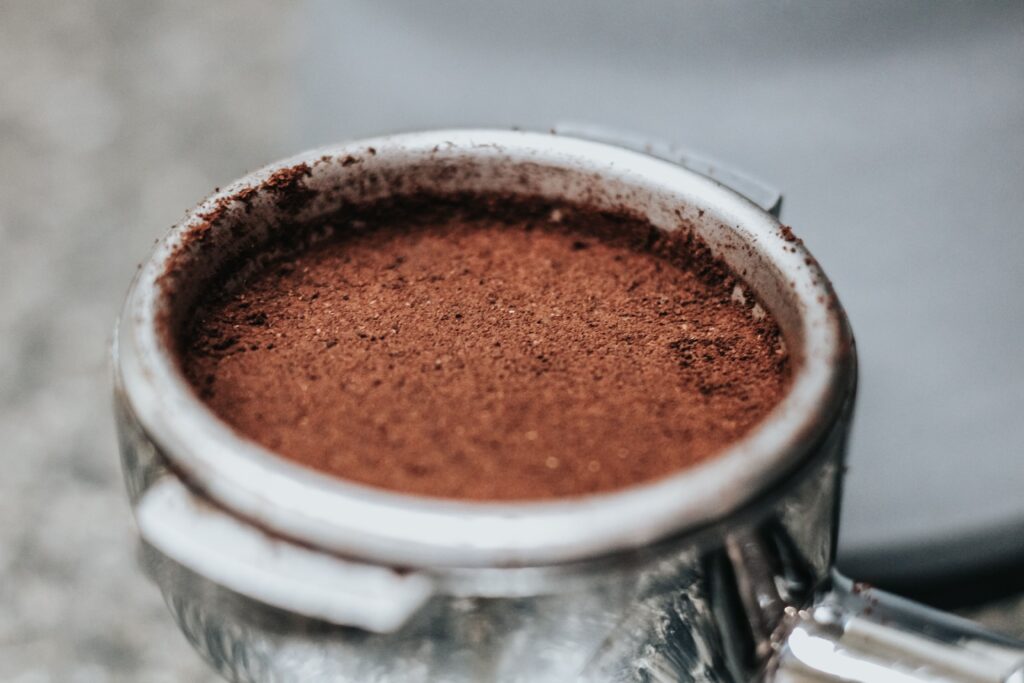
What is Ground Coffee?
New to coffee? There is a lot of terminology in the world of coffee. It can be quite daunting for someone who is only just starting to learn to appreciate coffee and getting into this global beverage for the first time.
One of the first terms you will no doubt come across is ‘ground coffee’, but what is ground coffee?

Looking for ground coffee?
Freshly roasted with 
So, what is ground coffee?
In nutshell, ground coffee is what brewed coffee is made of. This means It is the most common form of coffee which is found in shops (apart from the beans themselves).
To understand this, we will start from the beginning:
All coffee comes from the coffee tree (genus Coffea). The tree’s cherries are picked and processed to gain access to the tiny seeds they contain, which are called green coffee beans. These green coffee beans are then roasted before being ready for consumption and are called whole coffee beans.
Before being brewed however, whole coffee beans are ground into smaller particles to extract as much flavour as possible.
This can be accomplished using a variety of tools including electric coffee grinders, blenders, mortar and pestles, or food processors. After being ground in one of these devices, whole coffee beans are referred to as ‘ground coffee’.
Coffee grind sizes
The more you process the coffee, the finer the coffee particles will get. The grades of ground coffee that are often used include:
Coarse ground coffee
Chunky particles of coffee that are about the size of kosher salt.
Medium ground coffee
Gritty particles that are about the size of coarse sand.
Fine
Smooth to the touch particles about the same size as granules of table salt or sugar.
Extra fine
Extremely find particles that are smaller than granules of table salt or sugar.
Turkish
A fine powder that resembles flour.
It’s important to keep your chosen brewing technique in mind when preparing ground coffee as some brewing techniques and coffee equipment will need coarser or finer coffee particles. In general terms:
- Plunger pots and French-presses require Coarse Ground Coffee
- Percolators require Coarse Ground Coffee
- Vacuum coffee pots require Coarse Ground Coffee
- Drip coffee makers with flat borrowed filters require a Medium Ground Coffee
- Drip coffee makers (such as the Hario V60 Coffee Dripper) with cone borrowed filters require a Fine Ground Coffee
- Espresso mocha pots (such as the Bialetti Stovetop) require Fine Ground Coffee
- Espresso machines require Extra Fine Ground Coffee
- Ibriks require Turkish Ground Coffee (extremely fine coffee)
If you don’t have a grinder, you can buy pre-packaged ground coffee. You can even browse our ground coffee options or opt for a coffee bean subscription (including a decaf coffee subscription, if that’s your preference).
The main advantages of buying coffee this way is that you avoid the hassle of grinding it yourself and you know that it has been ground to the specific coarseness you require.
How long does ground coffee stay fresh?
Once the coffee has been roasted it begins to oxidise fairly quickly. Oxidisation occurs when oxygen molecules come into contact with compounds in coffee, altering their structure.
This will affect the acids, aromatics and oils in the coffee — dramatically changing how the coffee tastes and smells.
When coffee has been ground it will oxidise even faster because there is more surface area exposed to oxygen. Additionally, the finer the grind of coffee, the faster it will oxidise.
In other words, a super-fine grind made for your espresso machine will oxidise many times faster than a coarse grind you made for your French press.
Medium or coarse-ground coffee length of time
Medium or coarse-ground coffee remains at peak freshness for a day or two. If kept in a vacuum-sealed container to protect it from oxygen, it might be up to 7-10 days before the coffee’s flavours and aromas begin to significantly decline. The good news is that this type of coffee will still be enjoyable in the weeks that follow, but it may not taste as fresh.
Finely ground coffee length of time
Finely ground coffee only remains fresh for a few hours and because of this many coffee aficionados believe that finely ground coffee that is going to be used for espresso must be brewed within a couple of minutes because due to its rapid oxidation.
If you are brewing espresso at home, it is usually best to grind whole beans and use your ground coffee immediately.
Whole coffee beans length of time
Whole coffee beans can remain at peak freshness for a week in a paper bag or for 3 to 4 weeks if kept in a vacuum-sealed container. That’s the reason why dedicated coffee drinkers will keep their coffee in bean form and grind it as they need it.
How Long Does Ground Coffee Last?
Although the flavour of ground coffee begins to decline very quickly, it can remain drinkable for several years. Ground coffee doesn’t really go bad unless it has been contaminated with water or another liquid!
Coffee that is a few months old may taste quite bland, but it won’t endanger your health.
How To Store Ground Coffee: Storing Ground Coffee Tips
Storing ground coffee properly will help you extend its freshness and get more enjoyment from your brew. Quite simply, the best way to store ground coffee ground properly is to do your best to keep it away from air, moisture, heat, and light.
Keep it shelved
The best place to store your coffee would be in an air tight container inside a cool, dark cupboard. You should also store your ground coffee in as small a container as possible, so the amount of air in contact with the coffee is limited, slowing the oxidisation process.
If you have a vacuum-sealed storage container, that is even better!
Freezing Coffee Beans
Never store your ground coffee in the refrigerator and don’t freeze it, as this may introduce moisture into your coffee, ruining it. If you have purchased ground coffee, don’t store it in the packet it came in, as it will not be airtight.
Thanks for reading our article. Hopefully, these tips on storing ground coffee will help you maximise the lifespan of your coffee beverages. For more articles, stay tuned!


25% off
your next order
Enjoy the world's best coffee, freshly roasted & delivered to your door. Sign up to our mailing list for a welcome pack and 25% off your next Cafédirect order!

Thanks for
joining our
mailing list
A welcome pack is on its way and you get 25% off your next Cafédirect order!
